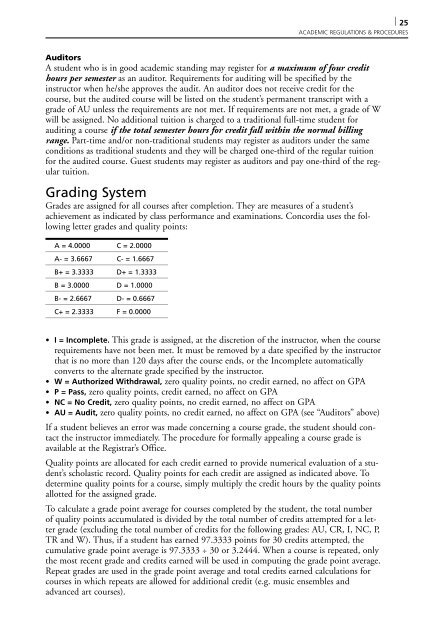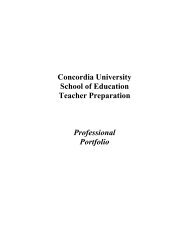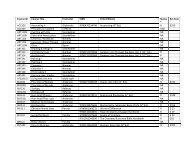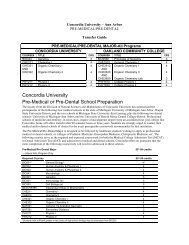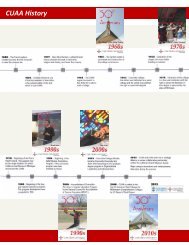2006â2007 Academic Catalog - Concordia University Ann Arbor
2006â2007 Academic Catalog - Concordia University Ann Arbor
2006â2007 Academic Catalog - Concordia University Ann Arbor
You also want an ePaper? Increase the reach of your titles
YUMPU automatically turns print PDFs into web optimized ePapers that Google loves.
| 25<br />
ACADEMIC REGULATIONS & PROCEDURES<br />
Auditors<br />
A student who is in good academic standing may register for a maximum of four credit<br />
hours per semester as an auditor. Requirements for auditing will be specified by the<br />
instructor when he/she approves the audit. An auditor does not receive credit for the<br />
course, but the audited course will be listed on the student’s permanent transcript with a<br />
grade of AU unless the requirements are not met. If requirements are not met, a grade of W<br />
will be assigned. No additional tuition is charged to a traditional full-time student for<br />
auditing a course if the total semester hours for credit fall within the normal billing<br />
range. Part-time and/or non-traditional students may register as auditors under the same<br />
conditions as traditional students and they will be charged one-third of the regular tuition<br />
for the audited course. Guest students may register as auditors and pay one-third of the regular<br />
tuition.<br />
Grading System<br />
Grades are assigned for all courses after completion. They are measures of a student’s<br />
achievement as indicated by class performance and examinations. <strong>Concordia</strong> uses the following<br />
letter grades and quality points:<br />
A = 4.0000 C = 2.0000<br />
A- = 3.6667 C- = 1.6667<br />
B+ = 3.3333 D+ = 1.3333<br />
B = 3.0000 D = 1.0000<br />
B- = 2.6667 D- = 0.6667<br />
C+ = 2.3333 F = 0.0000<br />
• I = Incomplete. This grade is assigned, at the discretion of the instructor, when the course<br />
requirements have not been met. It must be removed by a date specified by the instructor<br />
that is no more than 120 days after the course ends, or the Incomplete automatically<br />
converts to the alternate grade specified by the instructor.<br />
• W = Authorized Withdrawal, zero quality points, no credit earned, no affect on GPA<br />
• P = Pass, zero quality points, credit earned, no affect on GPA<br />
• NC = No Credit, zero quality points, no credit earned, no affect on GPA<br />
• AU = Audit, zero quality points, no credit earned, no affect on GPA (see “Auditors” above)<br />
If a student believes an error was made concerning a course grade, the student should contact<br />
the instructor immediately. The procedure for formally appealing a course grade is<br />
available at the Registrar’s Office.<br />
Quality points are allocated for each credit earned to provide numerical evaluation of a student’s<br />
scholastic record. Quality points for each credit are assigned as indicated above. To<br />
determine quality points for a course, simply multiply the credit hours by the quality points<br />
allotted for the assigned grade.<br />
To calculate a grade point average for courses completed by the student, the total number<br />
of quality points accumulated is divided by the total number of credits attempted for a letter<br />
grade (excluding the total number of credits for the following grades: AU, CR, I, NC, P,<br />
TR and W). Thus, if a student has earned 97.3333 points for 30 credits attempted, the<br />
cumulative grade point average is 97.3333 ÷ 30 or 3.2444. When a course is repeated, only<br />
the most recent grade and credits earned will be used in computing the grade point average.<br />
Repeat grades are used in the grade point average and total credits earned calculations for<br />
courses in which repeats are allowed for additional credit (e.g. music ensembles and<br />
advanced art courses).


